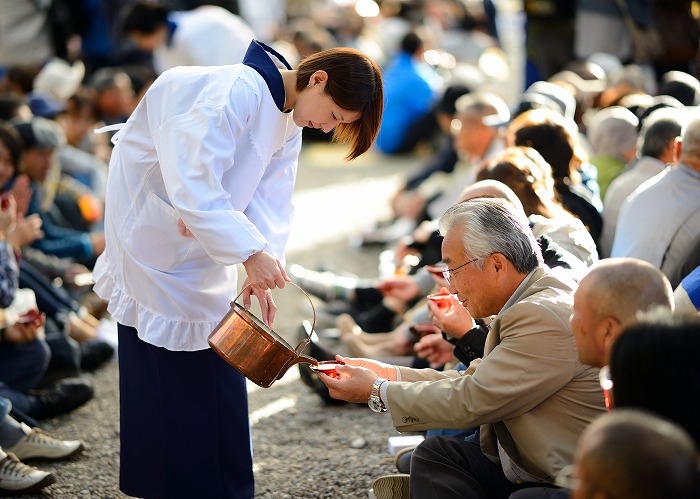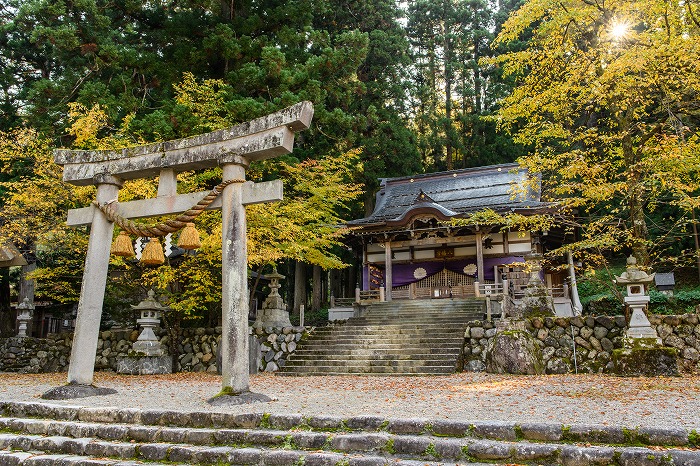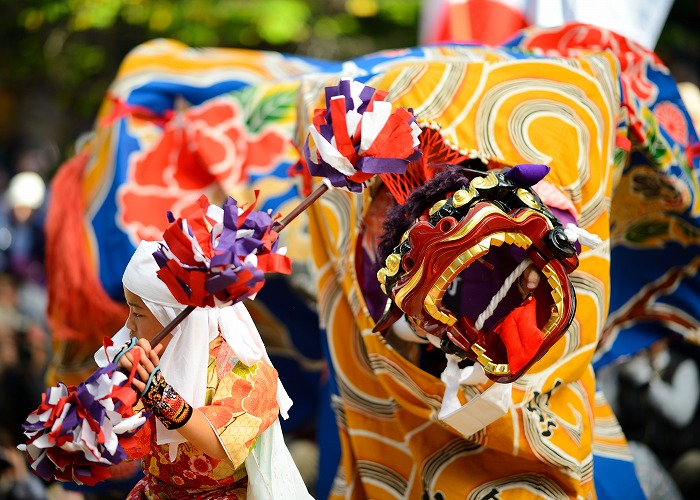最終更新日:2023年12月15日

Doburoku Festival
The Doburoku Festival is one of the most important events on Shirakawa-go’s annual calendar. Rather than a single occasion, it is a series of harvest festivals held in succession at local Shinto shrines between October 14 and 19 to celebrate the end of the farming season and to thank the gods for an abundant crop. The program varies little from shrine to shrine, consisting of religious ceremonies, including a procession in which a mikoshi (portable shrine) is paraded from house to house in the neighborhood, performances of lion dancing (shishimai) and other traditional arts, and the drinking of copious amounts of doburoku, or unfiltered sake. Each shrine brews its own doburoku, as has been customary since at least the early Edo period (1603–1867).
They have special brewing licenses, which were granted in 1896 after the government had banned home brewing and imposed strict regulations on liquor production. The shrines were exempt from these rules, provided that they brew sake only for religious purposes and refrain from selling their product for a profit. The Doburoku Festival at Shirakawa Hachimangu Shrine attracts the largest number of participants, many of whom come specifically to sample the shrine’s doburoku. In exchange for a donation of 400 yen, visitors receive a sake cup that can be refilled as many times as one likes.

Shirakawa Hachimangu Shrine
Shirakawa Hachimangu Shrine is the main Shinto sanctuary in Ogimachi. It is believed to have ancient origins, but the year of its establishment is unknown. The shrine first appears in recorded history in the seventeenth century, when it was rebuilt by Yamashita Ujikatsu (1568–1653), a samurai general who ruled Ogimachi on behalf of the family of the warlord Uchigashima. The shrine’s association with Hachiman, the guardian deity of warriors, is believed to date to this period.
Also from the seventeenth century are the Buddha statues housed in the Shakado Hall, next to the main sanctuary. Their presence reminds us how Shinto and Buddhism, now thought of as separate, were intimately linked in Japan for more than a thousand years. On the opposite side of the main sanctuary is the Mikiden, the building where the shrine’s sacred sake is brewed every winter. This sake is served to local devotees and visitors alike on October 14 and 15, when the annual Doburoku Festival is held at the shrine to celebrate the end of the farming season and to thank the gods for the harvest.

Centipede Lion Dancing (Mukade Shishimai)
Shishimai (Japanese lion dancing) is a traditional performing art, common throughout Japan, in which dancers wear a lion costume complete with a head represented by a mask. The choreography, costume, and number of participants vary significantly by locality. In Shirakawa-go, the lion is always represented by four dancers, whose eight feet are what give this version of the dance its name: mukade shishimai, or centipede lion dance. In mukade shishimai, the lion is opposed by two brave warriors called shishitori (or hanatori). This role is traditionally performed by children.
The performance consists of two main acts: In the first, the lion battles and eats a snake, considered a symbol of calamity; in the second, the shishitori rise to oppose the lion, which here represents disasters, disease, and various other ills. The shishitori defeat the lion, which in the climax, however, rises up to dance together with its vanquishers. The closing act reminds us that because nature cannot be tamed, humans must learn to live in harmony with it.
Performed locally since at least the late eighteenth century, mukade shishimai is unique to Shirakawa-go, but it incorporates influences from similar dances performed elsewhere along the Sho River. The parts that feature the lion dancing alone are similar to varieties of shishimai common in the Hida area, which is located upstream from Shirakawa-go, whereas the involvement of the shishitori is thought to have been adopted from traditions practiced in communities downstream, in what is now Toyama and Ishikawa Prefectures. Even mukade shishimai itself differs slightly from village to village; there are currently seven village associations that perform their own versions of the dance. Their talents can be appreciated in October, when mukade shishimai is danced throughout Shirakawa-go as part of the annual Doburoku Festival.
この英文解説は、2021年観光庁「地域観光資源の多言語解説整備支援事業」により整備しています。
This English description is provided by the "Multilingual Commentary Project 2020" of Japan Tourism Agency.

Back Home